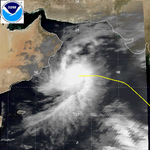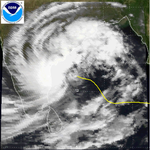1992 North Indian Ocean cyclone season
| 1992 North Indian Ocean cyclone season |

Season summary map
|
| Seasonal boundaries |
| First system formed |
May 16, 1992 |
| Last system dissipated |
December 24, 1992 |
| Strongest storm |
|
| Name |
Forrest |
| • Maximum winds |
185 km/h (115 mph)
(3-minute sustained) |
| • Lowest pressure |
952 hPa (mbar) |
| Seasonal statistics |
| Depressions |
13 |
| Deep depressions |
11 |
| Cyclonic storms |
7 |
| Severe cyclonic storms |
2 |
| Very severe cyclonic storms |
1 |
| Total fatalities |
400–949 total |
| Total damage |
At least $69 million (1992 USD) |
| Related articles |
|
|
North Indian Ocean tropical cyclone seasons
1990, 1991, 1992, 1993, 1994
|
| Cyclonic storm (IMD) |
| Category 1 tropical cyclone (SSHWS) |
|
|
| Duration |
May 16 – May 20 |
| Peak intensity |
65 km/h (40 mph) (3-min) 992 hPa (mbar) |
| Cyclonic storm (IMD) |
| Tropical storm (SSHWS) |
|
|
| Duration |
June 5 – June 12 |
| Peak intensity |
85 km/h (50 mph) (3-min) 994 hPa (mbar) |
| Deep depression (IMD) |
| Tropical storm (SSHWS) |
|
|
| Duration |
June 17 – June 18 |
| Peak intensity |
55 km/h (35 mph) (3-min) 980 hPa (mbar) |
| Deep depression (IMD) |
| Tropical storm (SSHWS) |
|
|
| Duration |
July 24 – July 28 |
| Peak intensity |
55 km/h (35 mph) (3-min) 984 hPa (mbar) |
| Tropical depression (SSHWS) |
|
|
| Duration |
September 22 – September 25 |
| Peak intensity |
55 km/h (35 mph) (1-min) 1000 hPa (mbar) |
| Cyclonic storm (IMD) |
| Tropical storm (SSHWS) |
|
|
| Duration |
September 29 – October 4 |
| Peak intensity |
85 km/h (50 mph) (3-min) 996 hPa (mbar) |
| Deep depression (IMD) |
| Tropical storm (SSHWS) |
|
|
| Duration |
October 6 – October 9 |
| Peak intensity |
55 km/h (35 mph) (3-min) 998 hPa (mbar) |
| Cyclonic storm (IMD) |
| Tropical depression (SSHWS) |
|
|
| Duration |
October 20 – October 22 |
| Peak intensity |
65 km/h (40 mph) (3-min) 996 hPa (mbar) |
| Cyclonic storm (IMD) |
| Tropical storm (SSHWS) |
|
|
| Duration |
November 3 – November 7 |
| Peak intensity |
85 km/h (50 mph) (3-min) 998 hPa (mbar) |
The 1992 North Indian Ocean cyclone season was unofficially the most active year on record for the basin with 10 tropical storms developing, according to the Joint Typhoon Warning Center (JTWC). There are two main seas in the North Indian Ocean – the Bay of Bengal to the east of the Indian subcontinent – and the Arabian Sea to the west of India. The official Regional Specialized Meteorological Centre in this basin is the India Meteorological Department (IMD), while the JTWC releases unofficial advisories. An average of four to six storms form in the North Indian Ocean every season with peaks in May and November. Cyclones occurring between the meridians 45°E and 100°E are included in the season by the IMD.
Overall, there was a total of 12 depressions, of which 7 became cyclonic storms, and 1 further strengthened to a very severe cyclonic storm. These totals were slightly above the long-term average of 5.4 cyclonic storms for the basin. In contrast to this, the JTWC reported record-breaking activity with 13 tropical cyclones, 11 of which became tropical storms. This included record activity in the months of October and November, each having three storms, while July saw its first system on record. The first storm of the year was Cyclonic Storm BOB 01 which formed on May 16 while the last was Deep Depression ARB 04 which dissipated over Somalia on December 24. The most intense was Very Severe Cyclonic Storm Forrest, which attained peak three-minute sustained winds of 185 km/h (115 mph). Severe Cyclonic Storm BOB 07 proved to be the deadliest and most destructive of the year, claiming 263–423 lives across southern India and leaving $69 million in damage. Collectively, the season's storms killed at least 400 people and left a further 549 missing.
Following six months of inactivity across the Northern Indian Ocean, a tropical disturbance developed within a monsoon trough over the Bay of Bengal on May 15. Initially poorly organized, the system developed into a tropical depression the following day as it moved northwestward. Intensification was slow at first as the storm turned to the northeast. As it approached Myanmar, the Joint Typhoon Warning Center (JTWC) estimated it to have attained winds of 120 km/h (75 mph), equivalent to a low-end Category 1 hurricane on the Saffir–Simpson hurricane scale. The Indian Meteorological Department (IMD), however, estimated the system to have been considerably weaker and only upgraded it to a cyclonic storm with 65 km/h (40 mph) was as it made landfall in Rakhine State on May 19. Once onshore, the storm accelerated and weakened, being last noted early on May 20 as a dissipating system near the Myanmar–China border.
...
Wikipedia



















